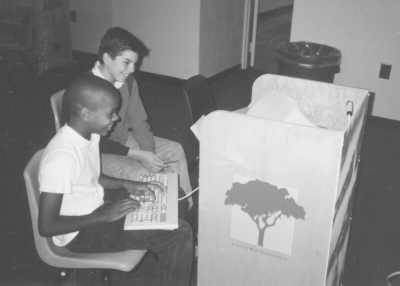In Concert with the Environment
In Concert With The Environment ( In Concert) is a customizable educational program developed by EcoGroup. It is sold to electric, natural gas, and water utilities in the U.S. who provide the program to local schools free of charge. In Concert teaches about careful use of resources, particularly energy and water use, providing a hands-on, real-life learning experience for students in grades 6-12, and their families.
Background
Between 1991 and 1996, In Concert was presented to over half a million students in 14 states. The following case study is taken from a participating utility in the Southern United States. The region served by the utility was both rural and urban, with a population of approximately two million. The utility began offering the program in 1993, following a one-year pilot program involving 2,054 students in 20 schools.
The utility chose to work with students from grades 7-8 because tests had shown better receptivity from students at this level. Other EcoGroup utility customers had chosen grade 9-10 students, anticipating a greater response rate from that level.
Delivering the Program
The program was based on a home survey which required students to question each member of their households about energy use. The resulting data were brought back to the school and entered into a computer. A personalized report was then printed out about home energy use, with suggestions for improvement. The report made use of bar charts showing the Eco Benefits and dollar savings that each household could obtain, as well as those already achieved. The "Eco Benefit" was a catch-all unit of environmental benefits that could be gained from wise utilization of natural resources by student participants. Tree icons were used on the bars to indicate Eco Benefits and dollar signs to indicate dollars saved (Vivid, Personalized Communication).
Students then took the report home and presented it to the household. Suggestions for presenting the report were provided in a section of the teachers' guide called, "Presenting your Case." The students asked for a commitment from their households to change household habits in order to use resources more efficiently. Together, the head of each household and the student checked off what they committed to do and then summed up the Eco Benefits earned. Some of the options provided included using the car 5 percent less often and upgrading insulation (Obtaining a Commitment).
In 1995, a formal commitment sheet was added to the report, called the Eco Benefits Action Plan (EBAP). Once completed it was signed by both the student and the head of the household. Two copies of the EBAP were included: one for the household to keep as a reminder of its commitment, and the other to return to the teacher. Teachers returned the EBAPs to the utility and the commitments were translated into kilowatt-hours saved, as well as other measures of resource savings. Letters could be generated by the program to the students as well as the heads of households thanking them for participating, reminding them of the specific actions they had agreed to, and soliciting their support in adopting the changes (Building Motivation Over Time).
A Student Handbook, as well as tests and activities, were provided in a comprehensive Teacher's Guide. The Student Handbook contained all the elements needed to understand the key environmental concepts of the program. A detailed exercise helped students to make sense of the report they received as a result of their survey. The activities, which illustrated the key concepts of the program, were highly praised and widely used by participating teachers.
During the pilot period and for the first year after the adoption of the program, computers were used. Facilitators provided an introduction to the program and supervised student data entry into the computers provided by the utility. During that time, 10,678 students participated in the program and the survey response rate averaged 80 percent.
The utility wanted to reach more families, but could not fund the support of computers and facilitators to expand the program using the computerized approach. Instead, EcoGroup provided an alternative in the form of scannable answer sheets for the survey. The sheets were first introduced in the spring of 1995 to over 6,000 students. The response rate of 67 percent using this format was lower than that achieved through the computerized approach. However, of those who did respond, a greater proportion completed their surveys fully. (They were required to fill in the sheet under teacher supervision.) The conclusion was that better data were gathered using the scannable answer sheet.
In the fall of 1995 and spring of 1996, participation rose to 13,239 students. An inexpensive incentive for returning the surveys was credited with increasing the average response rate back to 78 percent.
Measuring Achievements
A study of returned EBAPs was used to estimate action taken and kilowatt hours saved.
Results
During one year of the program with 1,500 participating students, and based on self-reported data:
- 1,142 households committed to 13,209 miles of reduced car use
- 1,017 committed to use setback thermostats, saving an estimated 2,000 kWh
- 6,308 commitments in all were made. If implemented, these would save an estimated 6,700 gallons of car fuel, 5,000 kWh of electricity, 8,500,000 gallons of water, and 2,000,000 pounds of carbon dioxide
Contacts
Carol Dickerson
Education Services Administrator
Education Foundation of the Electric League
1500 114th Ave. S.E., Suite 105
Bellevue, WA 98004-6914
U.S.A.
425-646-4727
Fax: 425-646-4729
E-mail: carold@electricleague.net
Web: www.electricleague.net/education/inconcert.htm
Notes
This case study was originally published in 1998 in "Tools of Change: Proven Methods for Promoting Environmental Citizenship" by Jay Kassirer and Doug McKenzie-Mohr (Published by Canada's National Round Table on the Environment and the Economy)
Search the Case Studies

